Human Resource Leadership: UAE Context and Practices Report
VerifiedAdded on 2022/09/27
|21
|5653
|21
Report
AI Summary
This report provides a detailed analysis of human resource leadership, focusing on its application within the United Arab Emirates (UAE). It begins by critiquing contemporary approaches to human resource management (HRM), contrasting the industrial and salaried models and examining their relevance in the UAE/GCC environment. The report then identifies and evaluates research evidence on effective HRM, learning, and development practices, exploring their impact on management thinking and practices, with specific examples from companies like Almarai. The discussion extends to employee engagement, analyzing key motivation, commitment, and engagement theories, such as the Two-Factor Theory and Expectancy Theory, and their relevance in modern organizations. It also illustrates how management practices have adapted these theoretical models. The report then transitions to leadership, evaluating what constitutes effective leadership within organizations, selecting a leader and assessing their characteristics, and identifying relevant leadership development activities. Finally, the report critiques the role of HR management and development, emphasizing the importance of collaboration between HR and other managers, the need for qualified HR practitioners, and how HR practices influence ethics and organizational culture. The report uses real-world examples to support its arguments, providing a comprehensive overview of HRM and leadership in the UAE.
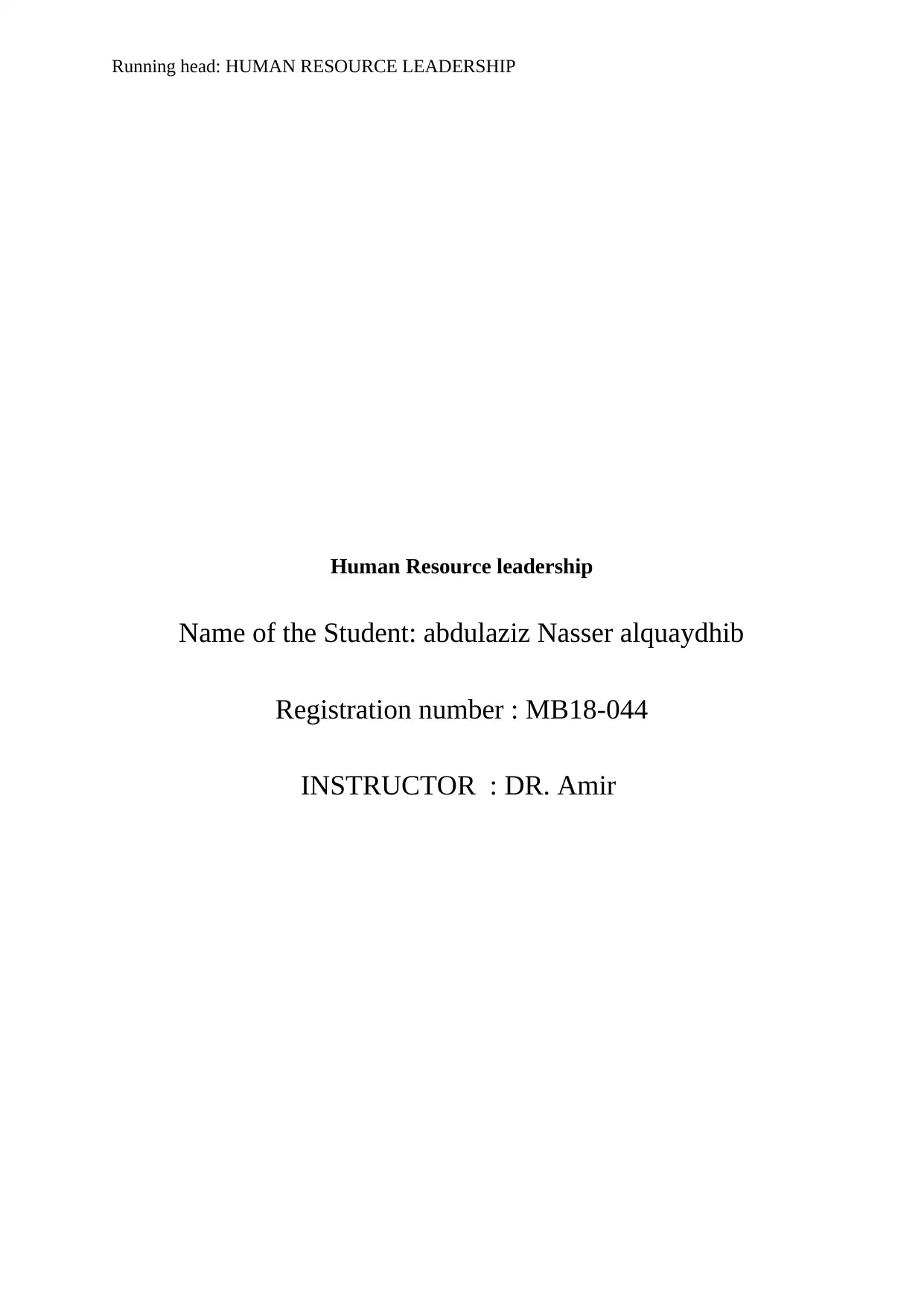
Running head: HUMAN RESOURCE LEADERSHIP
Human Resource leadership
Name of the Student: abdulaziz Nasser alquaydhib
Registration number : MB18-044
INSTRUCTOR : DR. Amir
Human Resource leadership
Name of the Student: abdulaziz Nasser alquaydhib
Registration number : MB18-044
INSTRUCTOR : DR. Amir
Paraphrase This Document
Need a fresh take? Get an instant paraphrase of this document with our AI Paraphraser
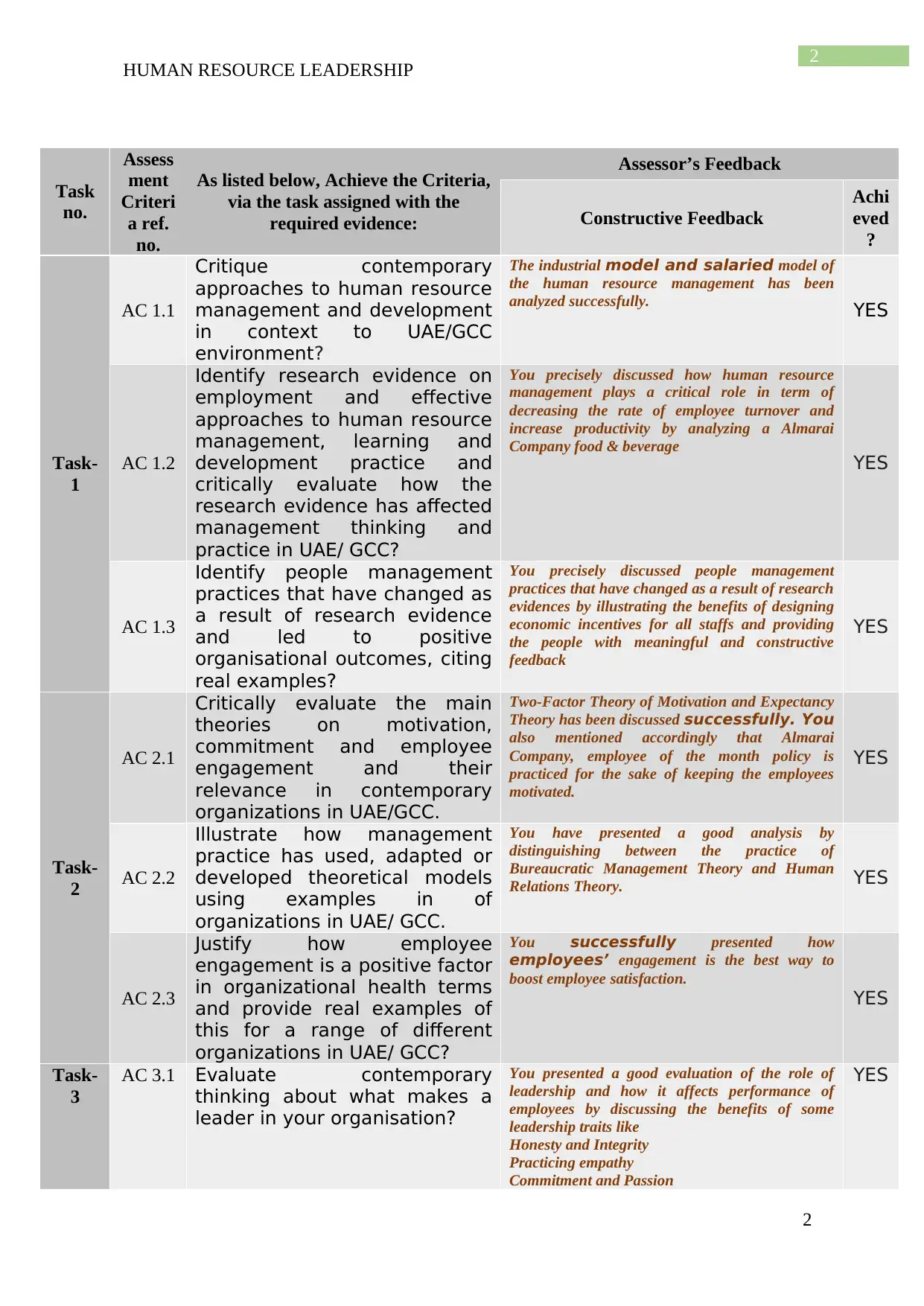
2
HUMAN RESOURCE LEADERSHIP
Task
no.
Assess
ment
Criteri
a ref.
no.
As listed below, Achieve the Criteria,
via the task assigned with the
required evidence:
Assessor’s Feedback
Constructive Feedback
Achi
eved
?
Task-
1
AC 1.1
Critique contemporary
approaches to human resource
management and development
in context to UAE/GCC
environment?
The industrial model and salaried model of
the human resource management has been
analyzed successfully. YES
AC 1.2
Identify research evidence on
employment and effective
approaches to human resource
management, learning and
development practice and
critically evaluate how the
research evidence has affected
management thinking and
practice in UAE/ GCC?
You precisely discussed how human resource
management plays a critical role in term of
decreasing the rate of employee turnover and
increase productivity by analyzing a Almarai
Company food & beverage
YES
AC 1.3
Identify people management
practices that have changed as
a result of research evidence
and led to positive
organisational outcomes, citing
real examples?
You precisely discussed people management
practices that have changed as a result of research
evidences by illustrating the benefits of designing
economic incentives for all staffs and providing
the people with meaningful and constructive
feedback
YES
Task-
2
AC 2.1
Critically evaluate the main
theories on motivation,
commitment and employee
engagement and their
relevance in contemporary
organizations in UAE/GCC.
Two-Factor Theory of Motivation and Expectancy
Theory has been discussed successfully. You
also mentioned accordingly that Almarai
Company, employee of the month policy is
practiced for the sake of keeping the employees
motivated.
YES
AC 2.2
Illustrate how management
practice has used, adapted or
developed theoretical models
using examples in of
organizations in UAE/ GCC.
You have presented a good analysis by
distinguishing between the practice of
Bureaucratic Management Theory and Human
Relations Theory. YES
AC 2.3
Justify how employee
engagement is a positive factor
in organizational health terms
and provide real examples of
this for a range of different
organizations in UAE/ GCC?
You successfully presented how
employees’ engagement is the best way to
boost employee satisfaction.
YES
Task-
3
AC 3.1 Evaluate contemporary
thinking about what makes a
leader in your organisation?
You presented a good evaluation of the role of
leadership and how it affects performance of
employees by discussing the benefits of some
leadership traits like
Honesty and Integrity
Practicing empathy
Commitment and Passion
YES
2
HUMAN RESOURCE LEADERSHIP
Task
no.
Assess
ment
Criteri
a ref.
no.
As listed below, Achieve the Criteria,
via the task assigned with the
required evidence:
Assessor’s Feedback
Constructive Feedback
Achi
eved
?
Task-
1
AC 1.1
Critique contemporary
approaches to human resource
management and development
in context to UAE/GCC
environment?
The industrial model and salaried model of
the human resource management has been
analyzed successfully. YES
AC 1.2
Identify research evidence on
employment and effective
approaches to human resource
management, learning and
development practice and
critically evaluate how the
research evidence has affected
management thinking and
practice in UAE/ GCC?
You precisely discussed how human resource
management plays a critical role in term of
decreasing the rate of employee turnover and
increase productivity by analyzing a Almarai
Company food & beverage
YES
AC 1.3
Identify people management
practices that have changed as
a result of research evidence
and led to positive
organisational outcomes, citing
real examples?
You precisely discussed people management
practices that have changed as a result of research
evidences by illustrating the benefits of designing
economic incentives for all staffs and providing
the people with meaningful and constructive
feedback
YES
Task-
2
AC 2.1
Critically evaluate the main
theories on motivation,
commitment and employee
engagement and their
relevance in contemporary
organizations in UAE/GCC.
Two-Factor Theory of Motivation and Expectancy
Theory has been discussed successfully. You
also mentioned accordingly that Almarai
Company, employee of the month policy is
practiced for the sake of keeping the employees
motivated.
YES
AC 2.2
Illustrate how management
practice has used, adapted or
developed theoretical models
using examples in of
organizations in UAE/ GCC.
You have presented a good analysis by
distinguishing between the practice of
Bureaucratic Management Theory and Human
Relations Theory. YES
AC 2.3
Justify how employee
engagement is a positive factor
in organizational health terms
and provide real examples of
this for a range of different
organizations in UAE/ GCC?
You successfully presented how
employees’ engagement is the best way to
boost employee satisfaction.
YES
Task-
3
AC 3.1 Evaluate contemporary
thinking about what makes a
leader in your organisation?
You presented a good evaluation of the role of
leadership and how it affects performance of
employees by discussing the benefits of some
leadership traits like
Honesty and Integrity
Practicing empathy
Commitment and Passion
YES
2
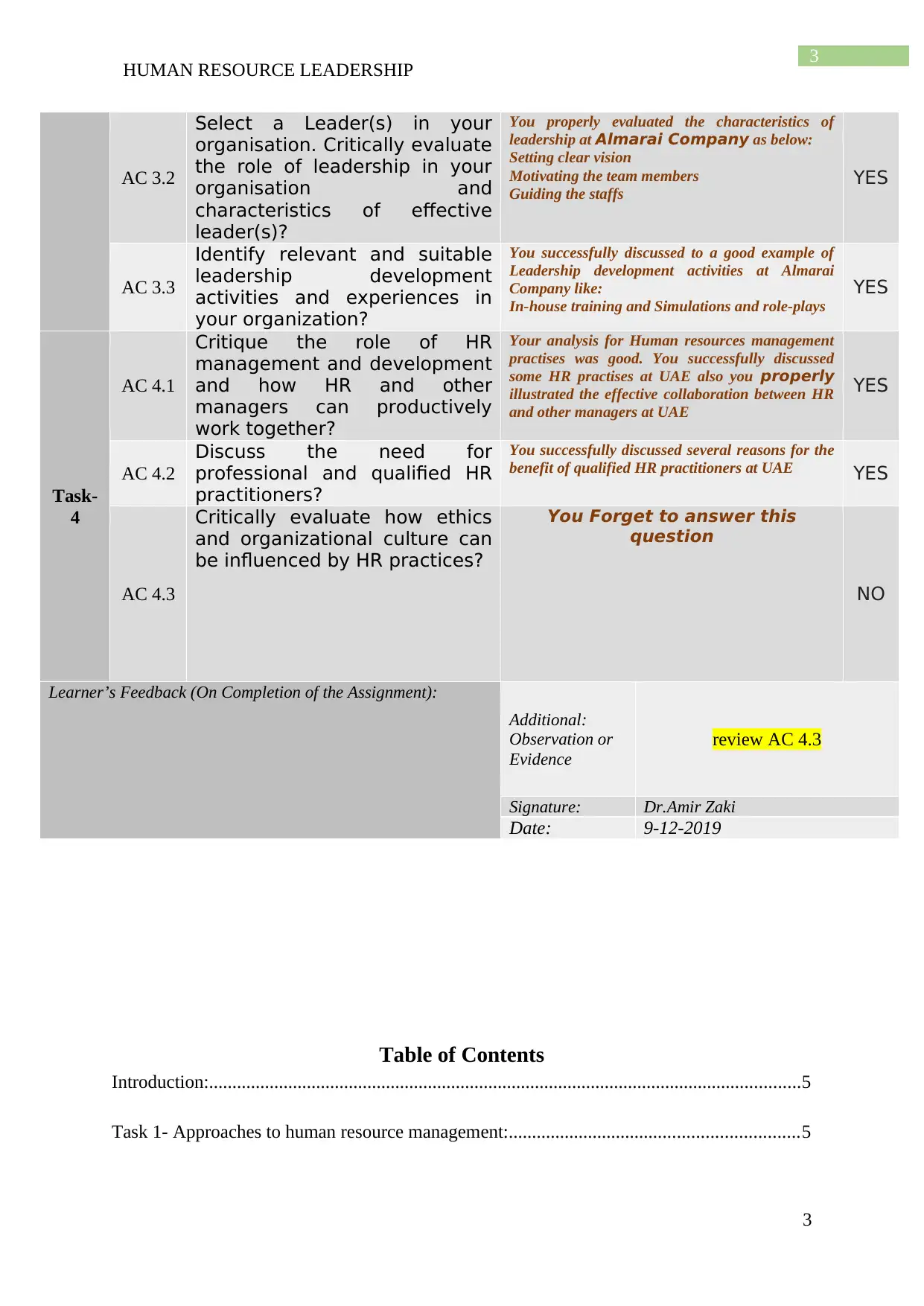
3
HUMAN RESOURCE LEADERSHIP
AC 3.2
Select a Leader(s) in your
organisation. Critically evaluate
the role of leadership in your
organisation and
characteristics of effective
leader(s)?
You properly evaluated the characteristics of
leadership at Almarai Company as below:
Setting clear vision
Motivating the team members
Guiding the staffs YES
AC 3.3
Identify relevant and suitable
leadership development
activities and experiences in
your organization?
You successfully discussed to a good example of
Leadership development activities at Almarai
Company like:
In-house training and Simulations and role-plays
YES
Task-
4
AC 4.1
Critique the role of HR
management and development
and how HR and other
managers can productively
work together?
Your analysis for Human resources management
practises was good. You successfully discussed
some HR practises at UAE also you properly
illustrated the effective collaboration between HR
and other managers at UAE
YES
AC 4.2
Discuss the need for
professional and qualified HR
practitioners?
You successfully discussed several reasons for the
benefit of qualified HR practitioners at UAE YES
AC 4.3
Critically evaluate how ethics
and organizational culture can
be influenced by HR practices?
You Forget to answer this
question
NO
Learner’s Feedback (On Completion of the Assignment):
Additional:
Observation or
Evidence
review AC 4.3
Signature: Dr.Amir Zaki
Date: 9-12-2019
Table of Contents
Introduction:...............................................................................................................................5
Task 1- Approaches to human resource management:..............................................................5
3
HUMAN RESOURCE LEADERSHIP
AC 3.2
Select a Leader(s) in your
organisation. Critically evaluate
the role of leadership in your
organisation and
characteristics of effective
leader(s)?
You properly evaluated the characteristics of
leadership at Almarai Company as below:
Setting clear vision
Motivating the team members
Guiding the staffs YES
AC 3.3
Identify relevant and suitable
leadership development
activities and experiences in
your organization?
You successfully discussed to a good example of
Leadership development activities at Almarai
Company like:
In-house training and Simulations and role-plays
YES
Task-
4
AC 4.1
Critique the role of HR
management and development
and how HR and other
managers can productively
work together?
Your analysis for Human resources management
practises was good. You successfully discussed
some HR practises at UAE also you properly
illustrated the effective collaboration between HR
and other managers at UAE
YES
AC 4.2
Discuss the need for
professional and qualified HR
practitioners?
You successfully discussed several reasons for the
benefit of qualified HR practitioners at UAE YES
AC 4.3
Critically evaluate how ethics
and organizational culture can
be influenced by HR practices?
You Forget to answer this
question
NO
Learner’s Feedback (On Completion of the Assignment):
Additional:
Observation or
Evidence
review AC 4.3
Signature: Dr.Amir Zaki
Date: 9-12-2019
Table of Contents
Introduction:...............................................................................................................................5
Task 1- Approaches to human resource management:..............................................................5
3
⊘ This is a preview!⊘
Do you want full access?
Subscribe today to unlock all pages.

Trusted by 1+ million students worldwide
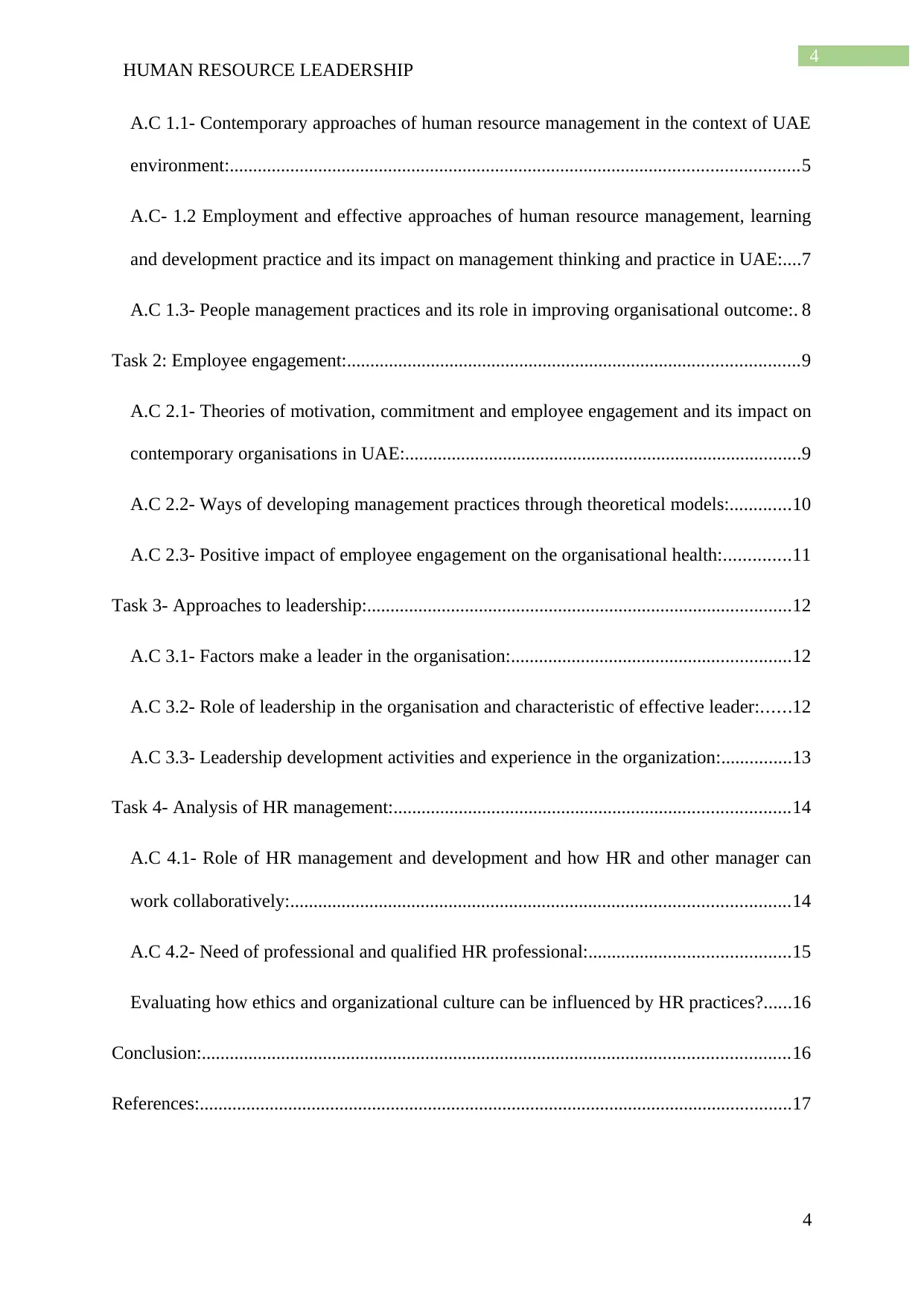
4
HUMAN RESOURCE LEADERSHIP
A.C 1.1- Contemporary approaches of human resource management in the context of UAE
environment:..........................................................................................................................5
A.C- 1.2 Employment and effective approaches of human resource management, learning
and development practice and its impact on management thinking and practice in UAE:....7
A.C 1.3- People management practices and its role in improving organisational outcome:. 8
Task 2: Employee engagement:.................................................................................................9
A.C 2.1- Theories of motivation, commitment and employee engagement and its impact on
contemporary organisations in UAE:.....................................................................................9
A.C 2.2- Ways of developing management practices through theoretical models:.............10
A.C 2.3- Positive impact of employee engagement on the organisational health:..............11
Task 3- Approaches to leadership:...........................................................................................12
A.C 3.1- Factors make a leader in the organisation:............................................................12
A.C 3.2- Role of leadership in the organisation and characteristic of effective leader:......12
A.C 3.3- Leadership development activities and experience in the organization:...............13
Task 4- Analysis of HR management:.....................................................................................14
A.C 4.1- Role of HR management and development and how HR and other manager can
work collaboratively:...........................................................................................................14
A.C 4.2- Need of professional and qualified HR professional:...........................................15
Evaluating how ethics and organizational culture can be influenced by HR practices?......16
Conclusion:..............................................................................................................................16
References:...............................................................................................................................17
4
HUMAN RESOURCE LEADERSHIP
A.C 1.1- Contemporary approaches of human resource management in the context of UAE
environment:..........................................................................................................................5
A.C- 1.2 Employment and effective approaches of human resource management, learning
and development practice and its impact on management thinking and practice in UAE:....7
A.C 1.3- People management practices and its role in improving organisational outcome:. 8
Task 2: Employee engagement:.................................................................................................9
A.C 2.1- Theories of motivation, commitment and employee engagement and its impact on
contemporary organisations in UAE:.....................................................................................9
A.C 2.2- Ways of developing management practices through theoretical models:.............10
A.C 2.3- Positive impact of employee engagement on the organisational health:..............11
Task 3- Approaches to leadership:...........................................................................................12
A.C 3.1- Factors make a leader in the organisation:............................................................12
A.C 3.2- Role of leadership in the organisation and characteristic of effective leader:......12
A.C 3.3- Leadership development activities and experience in the organization:...............13
Task 4- Analysis of HR management:.....................................................................................14
A.C 4.1- Role of HR management and development and how HR and other manager can
work collaboratively:...........................................................................................................14
A.C 4.2- Need of professional and qualified HR professional:...........................................15
Evaluating how ethics and organizational culture can be influenced by HR practices?......16
Conclusion:..............................................................................................................................16
References:...............................................................................................................................17
4
Paraphrase This Document
Need a fresh take? Get an instant paraphrase of this document with our AI Paraphraser
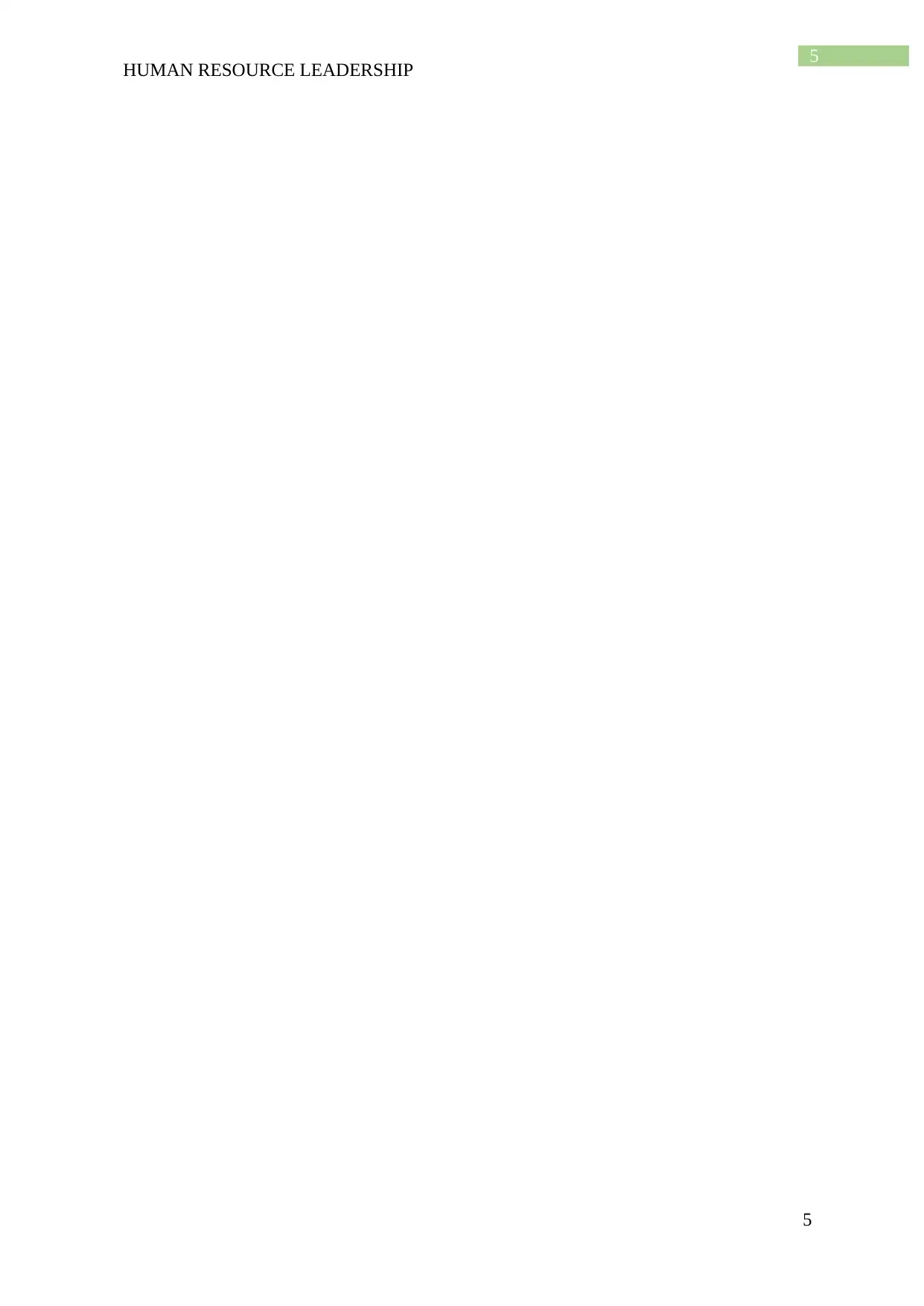
5
HUMAN RESOURCE LEADERSHIP
5
HUMAN RESOURCE LEADERSHIP
5
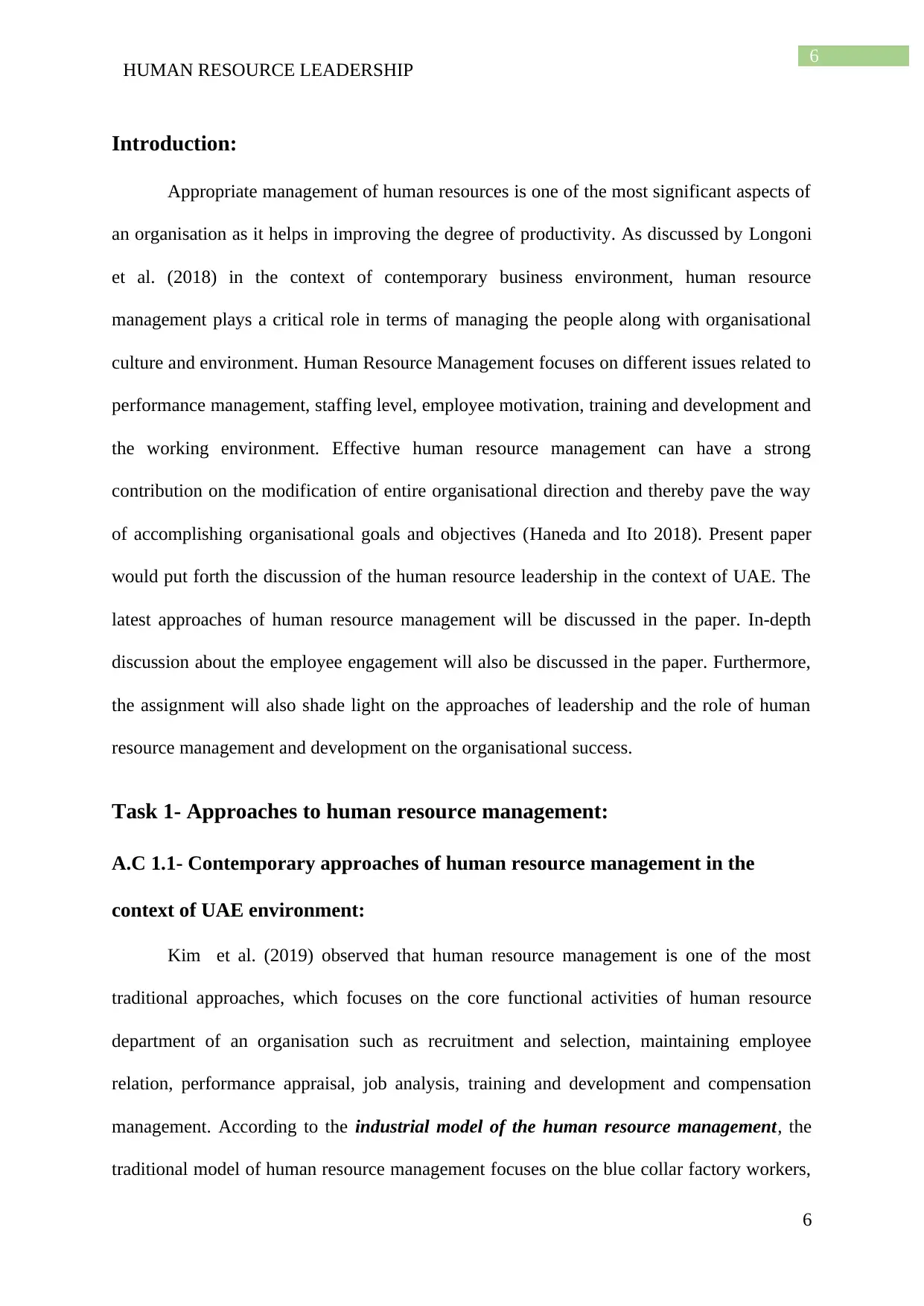
6
HUMAN RESOURCE LEADERSHIP
Introduction:
Appropriate management of human resources is one of the most significant aspects of
an organisation as it helps in improving the degree of productivity. As discussed by Longoni
et al. (2018) in the context of contemporary business environment, human resource
management plays a critical role in terms of managing the people along with organisational
culture and environment. Human Resource Management focuses on different issues related to
performance management, staffing level, employee motivation, training and development and
the working environment. Effective human resource management can have a strong
contribution on the modification of entire organisational direction and thereby pave the way
of accomplishing organisational goals and objectives (Haneda and Ito 2018). Present paper
would put forth the discussion of the human resource leadership in the context of UAE. The
latest approaches of human resource management will be discussed in the paper. In-depth
discussion about the employee engagement will also be discussed in the paper. Furthermore,
the assignment will also shade light on the approaches of leadership and the role of human
resource management and development on the organisational success.
Task 1- Approaches to human resource management:
A.C 1.1- Contemporary approaches of human resource management in the
context of UAE environment:
Kim et al. (2019) observed that human resource management is one of the most
traditional approaches, which focuses on the core functional activities of human resource
department of an organisation such as recruitment and selection, maintaining employee
relation, performance appraisal, job analysis, training and development and compensation
management. According to the industrial model of the human resource management, the
traditional model of human resource management focuses on the blue collar factory workers,
6
HUMAN RESOURCE LEADERSHIP
Introduction:
Appropriate management of human resources is one of the most significant aspects of
an organisation as it helps in improving the degree of productivity. As discussed by Longoni
et al. (2018) in the context of contemporary business environment, human resource
management plays a critical role in terms of managing the people along with organisational
culture and environment. Human Resource Management focuses on different issues related to
performance management, staffing level, employee motivation, training and development and
the working environment. Effective human resource management can have a strong
contribution on the modification of entire organisational direction and thereby pave the way
of accomplishing organisational goals and objectives (Haneda and Ito 2018). Present paper
would put forth the discussion of the human resource leadership in the context of UAE. The
latest approaches of human resource management will be discussed in the paper. In-depth
discussion about the employee engagement will also be discussed in the paper. Furthermore,
the assignment will also shade light on the approaches of leadership and the role of human
resource management and development on the organisational success.
Task 1- Approaches to human resource management:
A.C 1.1- Contemporary approaches of human resource management in the
context of UAE environment:
Kim et al. (2019) observed that human resource management is one of the most
traditional approaches, which focuses on the core functional activities of human resource
department of an organisation such as recruitment and selection, maintaining employee
relation, performance appraisal, job analysis, training and development and compensation
management. According to the industrial model of the human resource management, the
traditional model of human resource management focuses on the blue collar factory workers,
6
⊘ This is a preview!⊘
Do you want full access?
Subscribe today to unlock all pages.

Trusted by 1+ million students worldwide
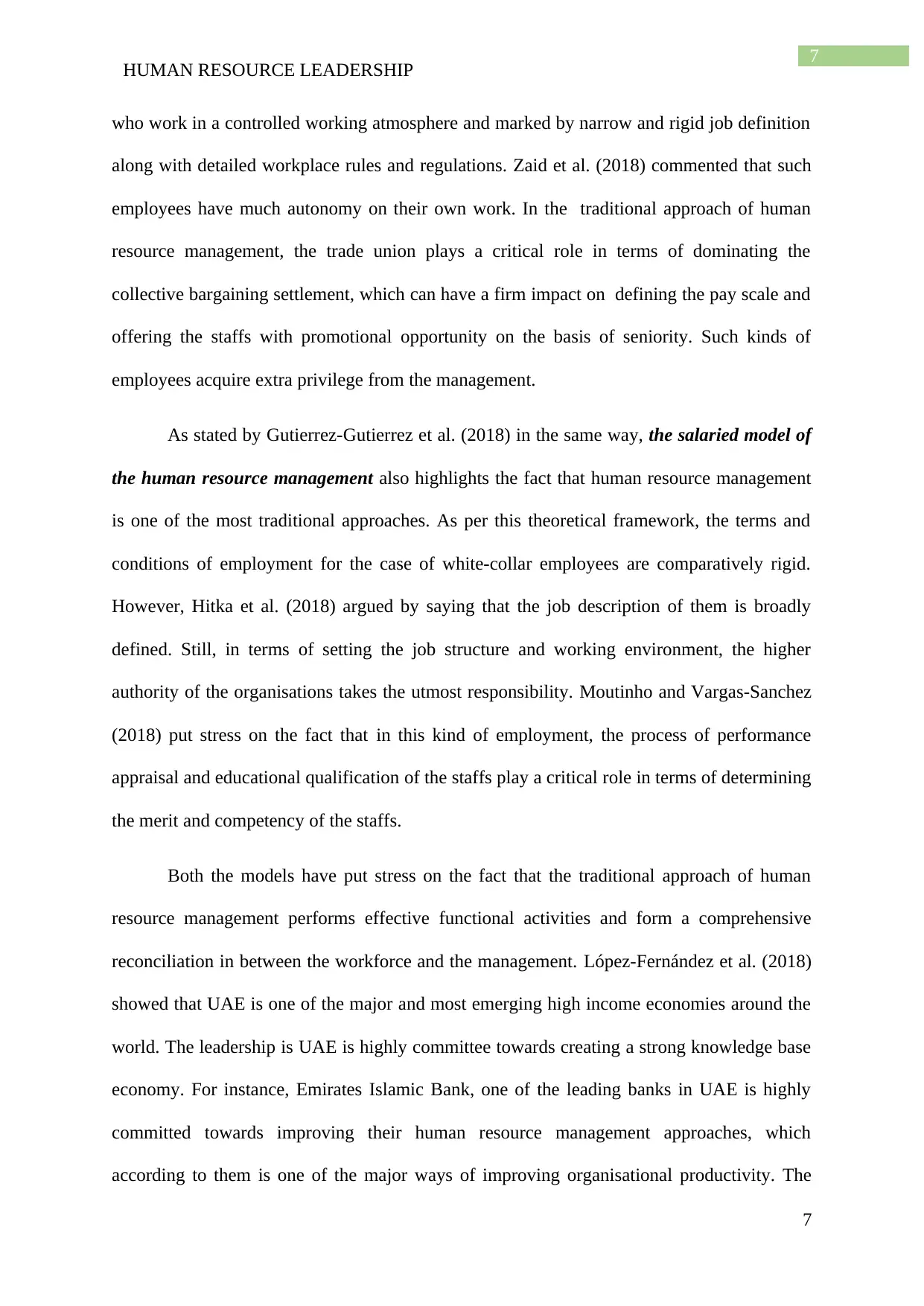
7
HUMAN RESOURCE LEADERSHIP
who work in a controlled working atmosphere and marked by narrow and rigid job definition
along with detailed workplace rules and regulations. Zaid et al. (2018) commented that such
employees have much autonomy on their own work. In the traditional approach of human
resource management, the trade union plays a critical role in terms of dominating the
collective bargaining settlement, which can have a firm impact on defining the pay scale and
offering the staffs with promotional opportunity on the basis of seniority. Such kinds of
employees acquire extra privilege from the management.
As stated by Gutierrez-Gutierrez et al. (2018) in the same way, the salaried model of
the human resource management also highlights the fact that human resource management
is one of the most traditional approaches. As per this theoretical framework, the terms and
conditions of employment for the case of white-collar employees are comparatively rigid.
However, Hitka et al. (2018) argued by saying that the job description of them is broadly
defined. Still, in terms of setting the job structure and working environment, the higher
authority of the organisations takes the utmost responsibility. Moutinho and Vargas-Sanchez
(2018) put stress on the fact that in this kind of employment, the process of performance
appraisal and educational qualification of the staffs play a critical role in terms of determining
the merit and competency of the staffs.
Both the models have put stress on the fact that the traditional approach of human
resource management performs effective functional activities and form a comprehensive
reconciliation in between the workforce and the management. López-Fernández et al. (2018)
showed that UAE is one of the major and most emerging high income economies around the
world. The leadership is UAE is highly committee towards creating a strong knowledge base
economy. For instance, Emirates Islamic Bank, one of the leading banks in UAE is highly
committed towards improving their human resource management approaches, which
according to them is one of the major ways of improving organisational productivity. The
7
HUMAN RESOURCE LEADERSHIP
who work in a controlled working atmosphere and marked by narrow and rigid job definition
along with detailed workplace rules and regulations. Zaid et al. (2018) commented that such
employees have much autonomy on their own work. In the traditional approach of human
resource management, the trade union plays a critical role in terms of dominating the
collective bargaining settlement, which can have a firm impact on defining the pay scale and
offering the staffs with promotional opportunity on the basis of seniority. Such kinds of
employees acquire extra privilege from the management.
As stated by Gutierrez-Gutierrez et al. (2018) in the same way, the salaried model of
the human resource management also highlights the fact that human resource management
is one of the most traditional approaches. As per this theoretical framework, the terms and
conditions of employment for the case of white-collar employees are comparatively rigid.
However, Hitka et al. (2018) argued by saying that the job description of them is broadly
defined. Still, in terms of setting the job structure and working environment, the higher
authority of the organisations takes the utmost responsibility. Moutinho and Vargas-Sanchez
(2018) put stress on the fact that in this kind of employment, the process of performance
appraisal and educational qualification of the staffs play a critical role in terms of determining
the merit and competency of the staffs.
Both the models have put stress on the fact that the traditional approach of human
resource management performs effective functional activities and form a comprehensive
reconciliation in between the workforce and the management. López-Fernández et al. (2018)
showed that UAE is one of the major and most emerging high income economies around the
world. The leadership is UAE is highly committee towards creating a strong knowledge base
economy. For instance, Emirates Islamic Bank, one of the leading banks in UAE is highly
committed towards improving their human resource management approaches, which
according to them is one of the major ways of improving organisational productivity. The
7
Paraphrase This Document
Need a fresh take? Get an instant paraphrase of this document with our AI Paraphraser
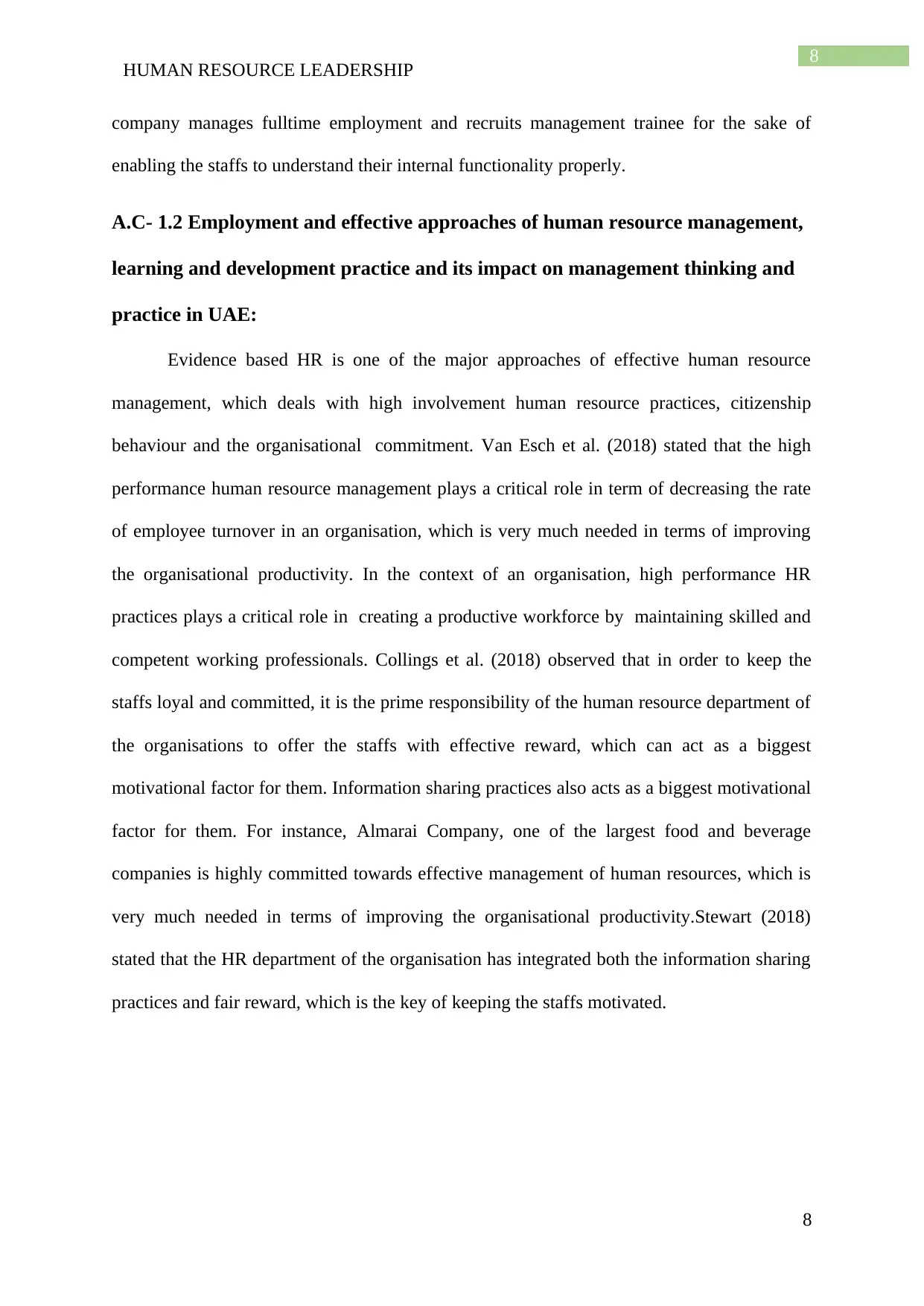
8
HUMAN RESOURCE LEADERSHIP
company manages fulltime employment and recruits management trainee for the sake of
enabling the staffs to understand their internal functionality properly.
A.C- 1.2 Employment and effective approaches of human resource management,
learning and development practice and its impact on management thinking and
practice in UAE:
Evidence based HR is one of the major approaches of effective human resource
management, which deals with high involvement human resource practices, citizenship
behaviour and the organisational commitment. Van Esch et al. (2018) stated that the high
performance human resource management plays a critical role in term of decreasing the rate
of employee turnover in an organisation, which is very much needed in terms of improving
the organisational productivity. In the context of an organisation, high performance HR
practices plays a critical role in creating a productive workforce by maintaining skilled and
competent working professionals. Collings et al. (2018) observed that in order to keep the
staffs loyal and committed, it is the prime responsibility of the human resource department of
the organisations to offer the staffs with effective reward, which can act as a biggest
motivational factor for them. Information sharing practices also acts as a biggest motivational
factor for them. For instance, Almarai Company, one of the largest food and beverage
companies is highly committed towards effective management of human resources, which is
very much needed in terms of improving the organisational productivity.Stewart (2018)
stated that the HR department of the organisation has integrated both the information sharing
practices and fair reward, which is the key of keeping the staffs motivated.
8
HUMAN RESOURCE LEADERSHIP
company manages fulltime employment and recruits management trainee for the sake of
enabling the staffs to understand their internal functionality properly.
A.C- 1.2 Employment and effective approaches of human resource management,
learning and development practice and its impact on management thinking and
practice in UAE:
Evidence based HR is one of the major approaches of effective human resource
management, which deals with high involvement human resource practices, citizenship
behaviour and the organisational commitment. Van Esch et al. (2018) stated that the high
performance human resource management plays a critical role in term of decreasing the rate
of employee turnover in an organisation, which is very much needed in terms of improving
the organisational productivity. In the context of an organisation, high performance HR
practices plays a critical role in creating a productive workforce by maintaining skilled and
competent working professionals. Collings et al. (2018) observed that in order to keep the
staffs loyal and committed, it is the prime responsibility of the human resource department of
the organisations to offer the staffs with effective reward, which can act as a biggest
motivational factor for them. Information sharing practices also acts as a biggest motivational
factor for them. For instance, Almarai Company, one of the largest food and beverage
companies is highly committed towards effective management of human resources, which is
very much needed in terms of improving the organisational productivity.Stewart (2018)
stated that the HR department of the organisation has integrated both the information sharing
practices and fair reward, which is the key of keeping the staffs motivated.
8
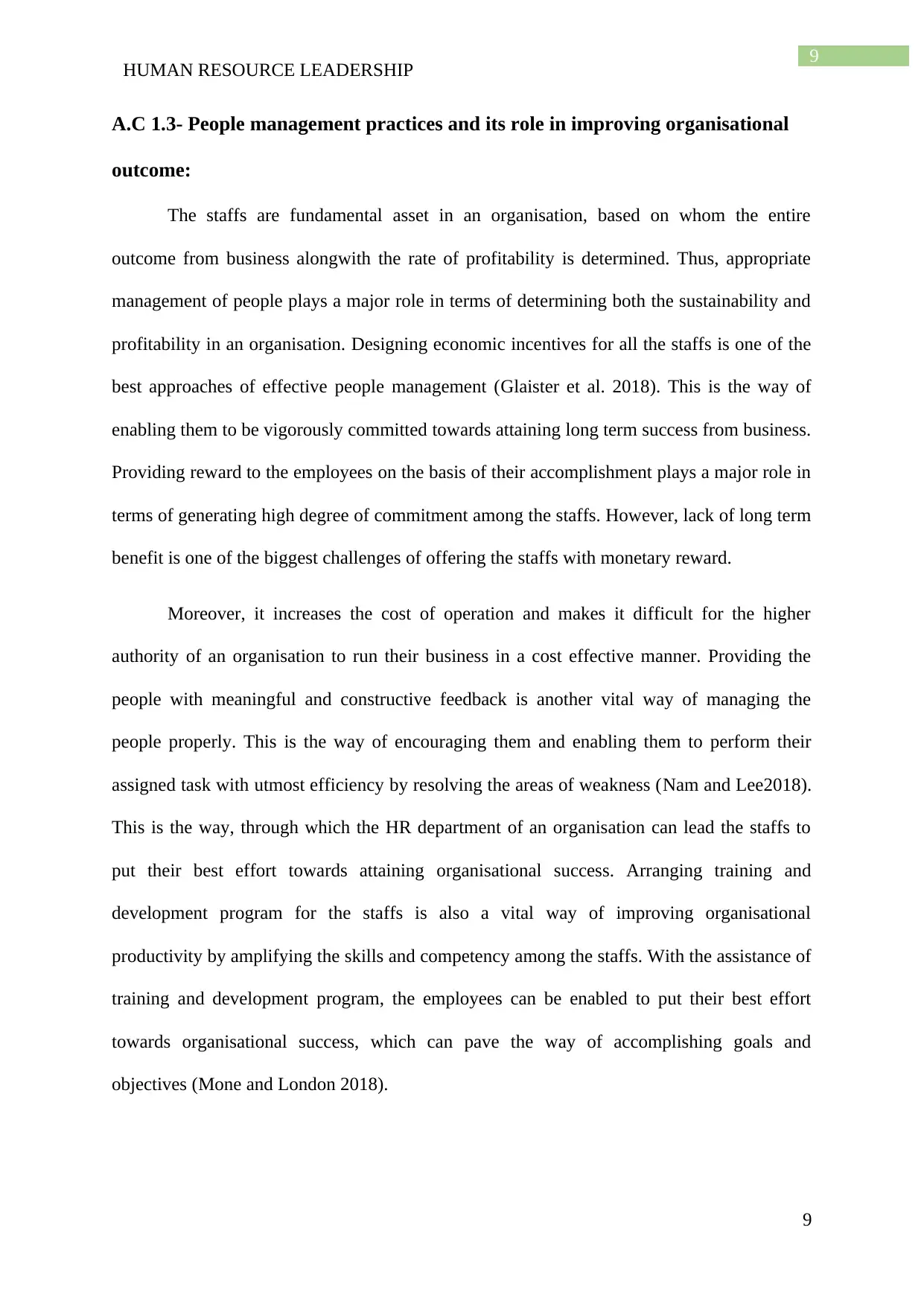
9
HUMAN RESOURCE LEADERSHIP
A.C 1.3- People management practices and its role in improving organisational
outcome:
The staffs are fundamental asset in an organisation, based on whom the entire
outcome from business alongwith the rate of profitability is determined. Thus, appropriate
management of people plays a major role in terms of determining both the sustainability and
profitability in an organisation. Designing economic incentives for all the staffs is one of the
best approaches of effective people management (Glaister et al. 2018). This is the way of
enabling them to be vigorously committed towards attaining long term success from business.
Providing reward to the employees on the basis of their accomplishment plays a major role in
terms of generating high degree of commitment among the staffs. However, lack of long term
benefit is one of the biggest challenges of offering the staffs with monetary reward.
Moreover, it increases the cost of operation and makes it difficult for the higher
authority of an organisation to run their business in a cost effective manner. Providing the
people with meaningful and constructive feedback is another vital way of managing the
people properly. This is the way of encouraging them and enabling them to perform their
assigned task with utmost efficiency by resolving the areas of weakness (Nam and Lee2018).
This is the way, through which the HR department of an organisation can lead the staffs to
put their best effort towards attaining organisational success. Arranging training and
development program for the staffs is also a vital way of improving organisational
productivity by amplifying the skills and competency among the staffs. With the assistance of
training and development program, the employees can be enabled to put their best effort
towards organisational success, which can pave the way of accomplishing goals and
objectives (Mone and London 2018).
9
HUMAN RESOURCE LEADERSHIP
A.C 1.3- People management practices and its role in improving organisational
outcome:
The staffs are fundamental asset in an organisation, based on whom the entire
outcome from business alongwith the rate of profitability is determined. Thus, appropriate
management of people plays a major role in terms of determining both the sustainability and
profitability in an organisation. Designing economic incentives for all the staffs is one of the
best approaches of effective people management (Glaister et al. 2018). This is the way of
enabling them to be vigorously committed towards attaining long term success from business.
Providing reward to the employees on the basis of their accomplishment plays a major role in
terms of generating high degree of commitment among the staffs. However, lack of long term
benefit is one of the biggest challenges of offering the staffs with monetary reward.
Moreover, it increases the cost of operation and makes it difficult for the higher
authority of an organisation to run their business in a cost effective manner. Providing the
people with meaningful and constructive feedback is another vital way of managing the
people properly. This is the way of encouraging them and enabling them to perform their
assigned task with utmost efficiency by resolving the areas of weakness (Nam and Lee2018).
This is the way, through which the HR department of an organisation can lead the staffs to
put their best effort towards attaining organisational success. Arranging training and
development program for the staffs is also a vital way of improving organisational
productivity by amplifying the skills and competency among the staffs. With the assistance of
training and development program, the employees can be enabled to put their best effort
towards organisational success, which can pave the way of accomplishing goals and
objectives (Mone and London 2018).
9
⊘ This is a preview!⊘
Do you want full access?
Subscribe today to unlock all pages.

Trusted by 1+ million students worldwide
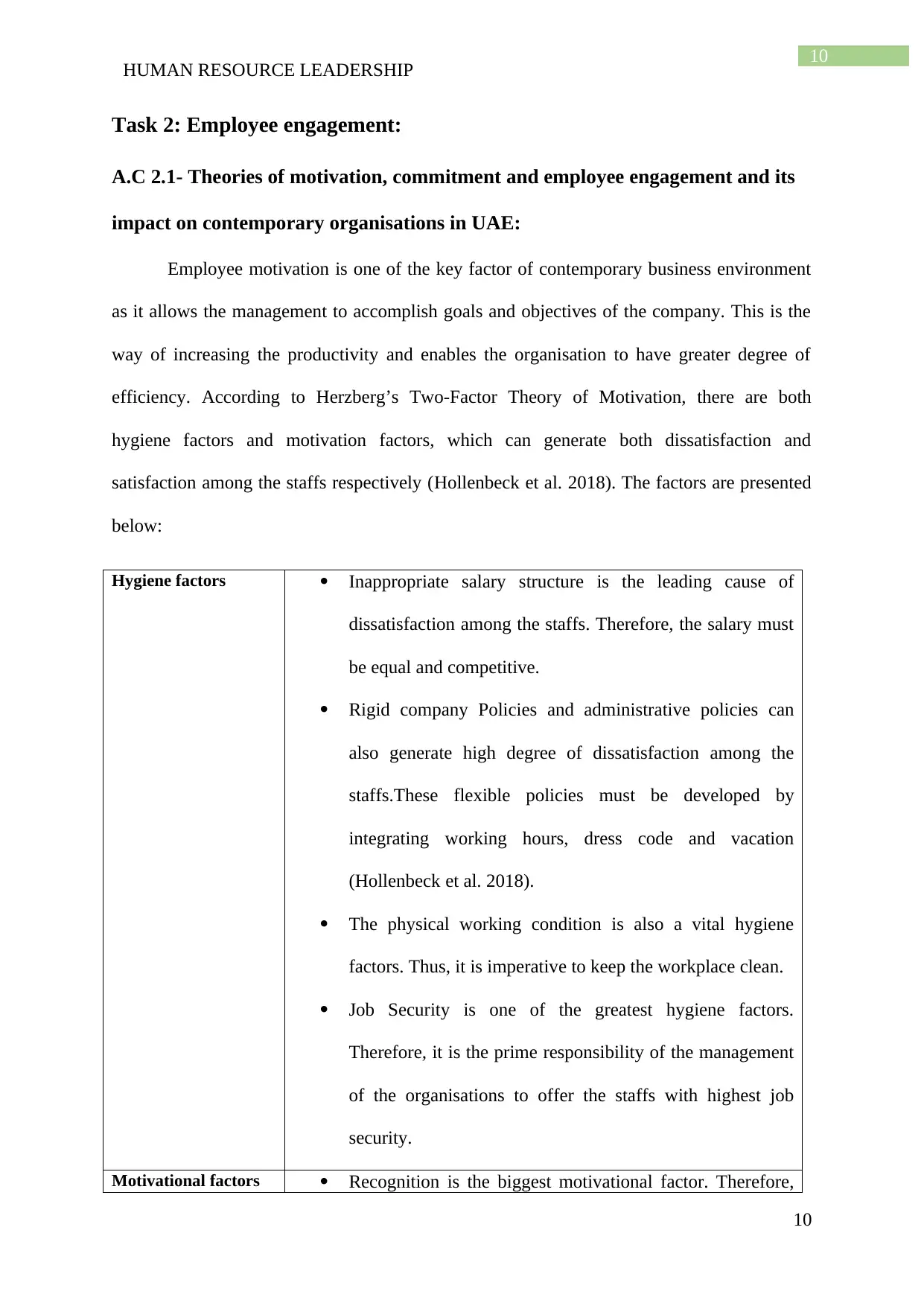
10
HUMAN RESOURCE LEADERSHIP
Task 2: Employee engagement:
A.C 2.1- Theories of motivation, commitment and employee engagement and its
impact on contemporary organisations in UAE:
Employee motivation is one of the key factor of contemporary business environment
as it allows the management to accomplish goals and objectives of the company. This is the
way of increasing the productivity and enables the organisation to have greater degree of
efficiency. According to Herzberg’s Two-Factor Theory of Motivation, there are both
hygiene factors and motivation factors, which can generate both dissatisfaction and
satisfaction among the staffs respectively (Hollenbeck et al. 2018). The factors are presented
below:
Hygiene factors Inappropriate salary structure is the leading cause of
dissatisfaction among the staffs. Therefore, the salary must
be equal and competitive.
Rigid company Policies and administrative policies can
also generate high degree of dissatisfaction among the
staffs.These flexible policies must be developed by
integrating working hours, dress code and vacation
(Hollenbeck et al. 2018).
The physical working condition is also a vital hygiene
factors. Thus, it is imperative to keep the workplace clean.
Job Security is one of the greatest hygiene factors.
Therefore, it is the prime responsibility of the management
of the organisations to offer the staffs with highest job
security.
Motivational factors Recognition is the biggest motivational factor. Therefore,
10
HUMAN RESOURCE LEADERSHIP
Task 2: Employee engagement:
A.C 2.1- Theories of motivation, commitment and employee engagement and its
impact on contemporary organisations in UAE:
Employee motivation is one of the key factor of contemporary business environment
as it allows the management to accomplish goals and objectives of the company. This is the
way of increasing the productivity and enables the organisation to have greater degree of
efficiency. According to Herzberg’s Two-Factor Theory of Motivation, there are both
hygiene factors and motivation factors, which can generate both dissatisfaction and
satisfaction among the staffs respectively (Hollenbeck et al. 2018). The factors are presented
below:
Hygiene factors Inappropriate salary structure is the leading cause of
dissatisfaction among the staffs. Therefore, the salary must
be equal and competitive.
Rigid company Policies and administrative policies can
also generate high degree of dissatisfaction among the
staffs.These flexible policies must be developed by
integrating working hours, dress code and vacation
(Hollenbeck et al. 2018).
The physical working condition is also a vital hygiene
factors. Thus, it is imperative to keep the workplace clean.
Job Security is one of the greatest hygiene factors.
Therefore, it is the prime responsibility of the management
of the organisations to offer the staffs with highest job
security.
Motivational factors Recognition is the biggest motivational factor. Therefore,
10
Paraphrase This Document
Need a fresh take? Get an instant paraphrase of this document with our AI Paraphraser
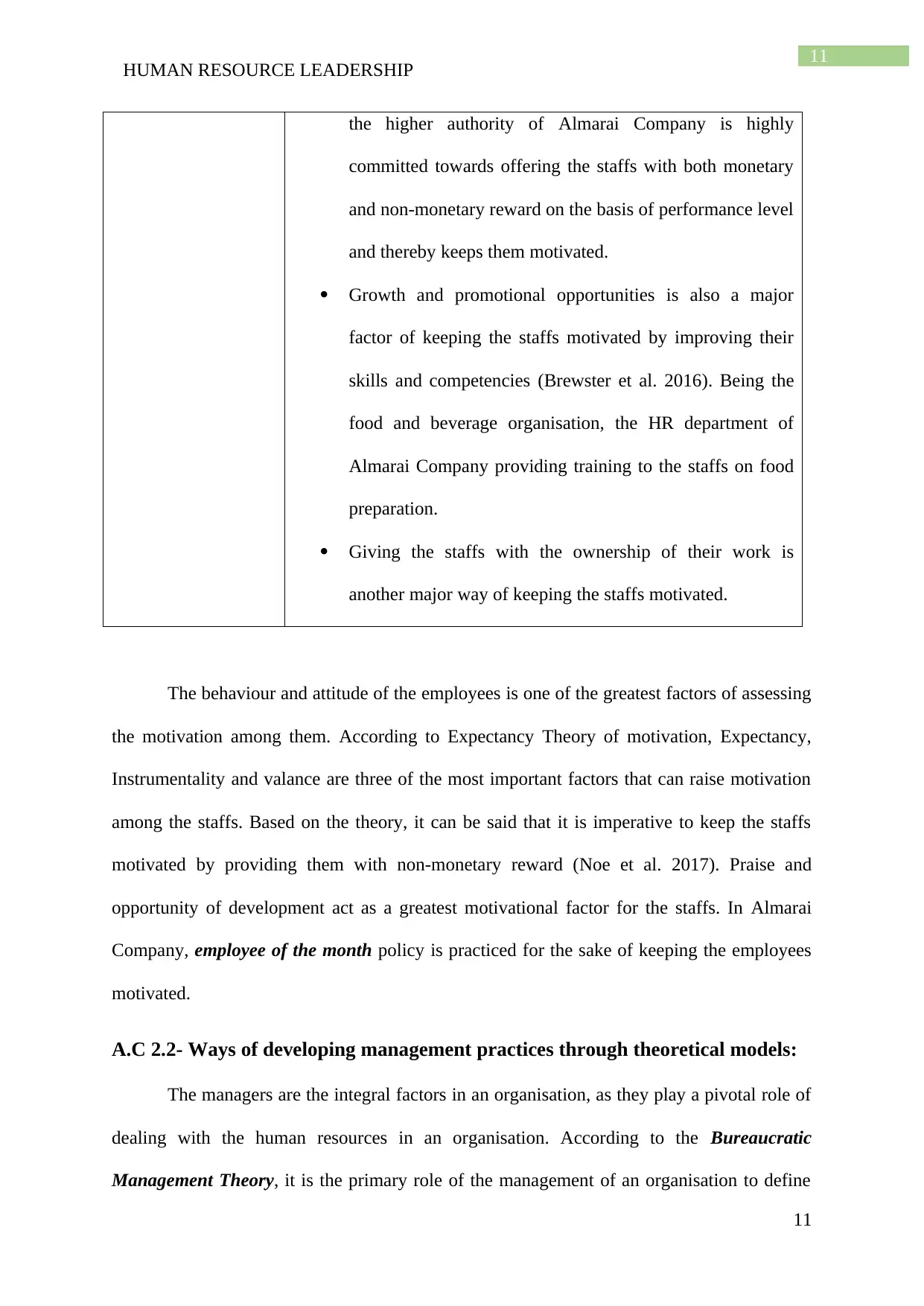
11
HUMAN RESOURCE LEADERSHIP
the higher authority of Almarai Company is highly
committed towards offering the staffs with both monetary
and non-monetary reward on the basis of performance level
and thereby keeps them motivated.
Growth and promotional opportunities is also a major
factor of keeping the staffs motivated by improving their
skills and competencies (Brewster et al. 2016). Being the
food and beverage organisation, the HR department of
Almarai Company providing training to the staffs on food
preparation.
Giving the staffs with the ownership of their work is
another major way of keeping the staffs motivated.
The behaviour and attitude of the employees is one of the greatest factors of assessing
the motivation among them. According to Expectancy Theory of motivation, Expectancy,
Instrumentality and valance are three of the most important factors that can raise motivation
among the staffs. Based on the theory, it can be said that it is imperative to keep the staffs
motivated by providing them with non-monetary reward (Noe et al. 2017). Praise and
opportunity of development act as a greatest motivational factor for the staffs. In Almarai
Company, employee of the month policy is practiced for the sake of keeping the employees
motivated.
A.C 2.2- Ways of developing management practices through theoretical models:
The managers are the integral factors in an organisation, as they play a pivotal role of
dealing with the human resources in an organisation. According to the Bureaucratic
Management Theory, it is the primary role of the management of an organisation to define
11
HUMAN RESOURCE LEADERSHIP
the higher authority of Almarai Company is highly
committed towards offering the staffs with both monetary
and non-monetary reward on the basis of performance level
and thereby keeps them motivated.
Growth and promotional opportunities is also a major
factor of keeping the staffs motivated by improving their
skills and competencies (Brewster et al. 2016). Being the
food and beverage organisation, the HR department of
Almarai Company providing training to the staffs on food
preparation.
Giving the staffs with the ownership of their work is
another major way of keeping the staffs motivated.
The behaviour and attitude of the employees is one of the greatest factors of assessing
the motivation among them. According to Expectancy Theory of motivation, Expectancy,
Instrumentality and valance are three of the most important factors that can raise motivation
among the staffs. Based on the theory, it can be said that it is imperative to keep the staffs
motivated by providing them with non-monetary reward (Noe et al. 2017). Praise and
opportunity of development act as a greatest motivational factor for the staffs. In Almarai
Company, employee of the month policy is practiced for the sake of keeping the employees
motivated.
A.C 2.2- Ways of developing management practices through theoretical models:
The managers are the integral factors in an organisation, as they play a pivotal role of
dealing with the human resources in an organisation. According to the Bureaucratic
Management Theory, it is the primary role of the management of an organisation to define
11
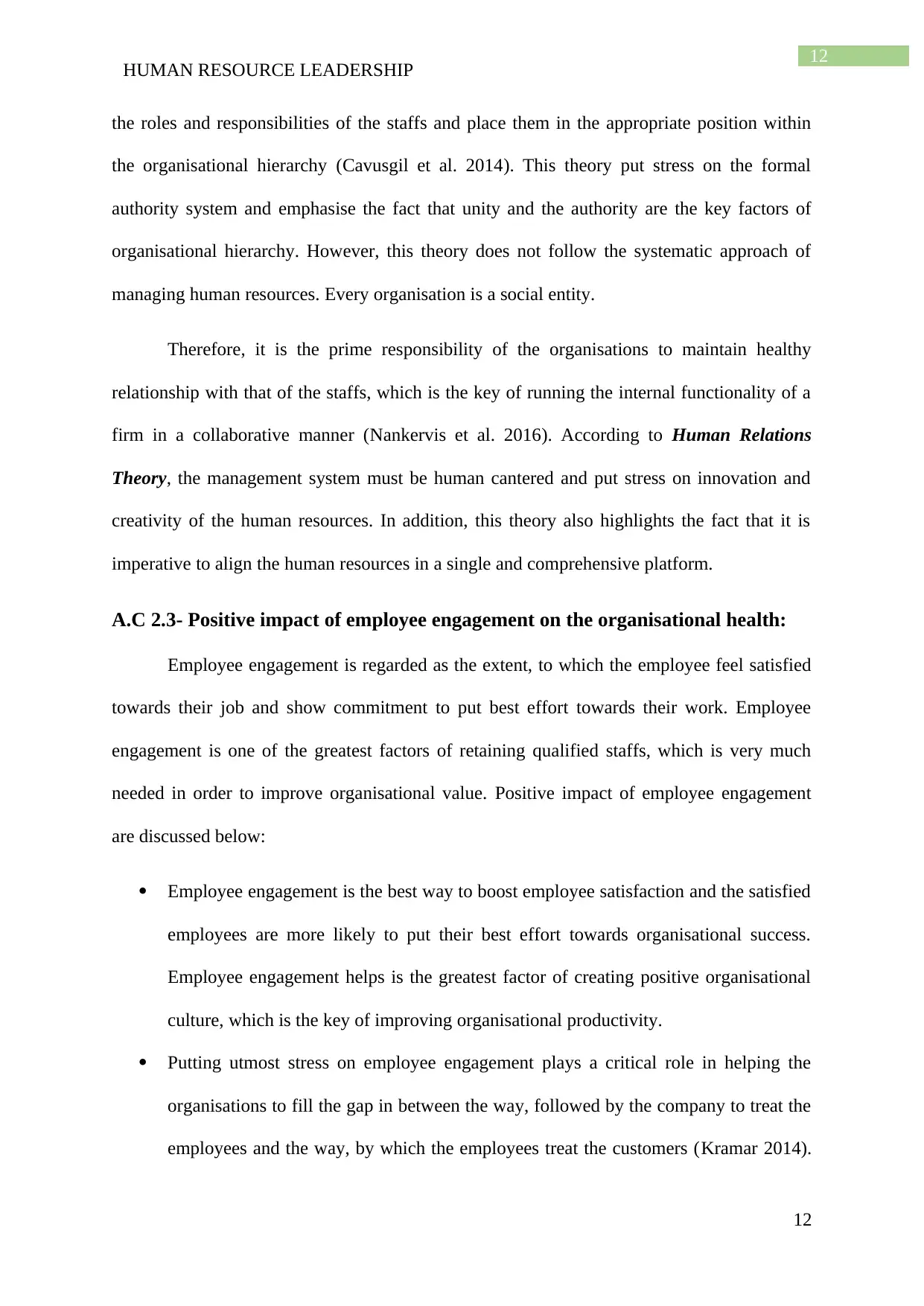
12
HUMAN RESOURCE LEADERSHIP
the roles and responsibilities of the staffs and place them in the appropriate position within
the organisational hierarchy (Cavusgil et al. 2014). This theory put stress on the formal
authority system and emphasise the fact that unity and the authority are the key factors of
organisational hierarchy. However, this theory does not follow the systematic approach of
managing human resources. Every organisation is a social entity.
Therefore, it is the prime responsibility of the organisations to maintain healthy
relationship with that of the staffs, which is the key of running the internal functionality of a
firm in a collaborative manner (Nankervis et al. 2016). According to Human Relations
Theory, the management system must be human cantered and put stress on innovation and
creativity of the human resources. In addition, this theory also highlights the fact that it is
imperative to align the human resources in a single and comprehensive platform.
A.C 2.3- Positive impact of employee engagement on the organisational health:
Employee engagement is regarded as the extent, to which the employee feel satisfied
towards their job and show commitment to put best effort towards their work. Employee
engagement is one of the greatest factors of retaining qualified staffs, which is very much
needed in order to improve organisational value. Positive impact of employee engagement
are discussed below:
Employee engagement is the best way to boost employee satisfaction and the satisfied
employees are more likely to put their best effort towards organisational success.
Employee engagement helps is the greatest factor of creating positive organisational
culture, which is the key of improving organisational productivity.
Putting utmost stress on employee engagement plays a critical role in helping the
organisations to fill the gap in between the way, followed by the company to treat the
employees and the way, by which the employees treat the customers (Kramar 2014).
12
HUMAN RESOURCE LEADERSHIP
the roles and responsibilities of the staffs and place them in the appropriate position within
the organisational hierarchy (Cavusgil et al. 2014). This theory put stress on the formal
authority system and emphasise the fact that unity and the authority are the key factors of
organisational hierarchy. However, this theory does not follow the systematic approach of
managing human resources. Every organisation is a social entity.
Therefore, it is the prime responsibility of the organisations to maintain healthy
relationship with that of the staffs, which is the key of running the internal functionality of a
firm in a collaborative manner (Nankervis et al. 2016). According to Human Relations
Theory, the management system must be human cantered and put stress on innovation and
creativity of the human resources. In addition, this theory also highlights the fact that it is
imperative to align the human resources in a single and comprehensive platform.
A.C 2.3- Positive impact of employee engagement on the organisational health:
Employee engagement is regarded as the extent, to which the employee feel satisfied
towards their job and show commitment to put best effort towards their work. Employee
engagement is one of the greatest factors of retaining qualified staffs, which is very much
needed in order to improve organisational value. Positive impact of employee engagement
are discussed below:
Employee engagement is the best way to boost employee satisfaction and the satisfied
employees are more likely to put their best effort towards organisational success.
Employee engagement helps is the greatest factor of creating positive organisational
culture, which is the key of improving organisational productivity.
Putting utmost stress on employee engagement plays a critical role in helping the
organisations to fill the gap in between the way, followed by the company to treat the
employees and the way, by which the employees treat the customers (Kramar 2014).
12
⊘ This is a preview!⊘
Do you want full access?
Subscribe today to unlock all pages.

Trusted by 1+ million students worldwide
1 out of 21
Related Documents
Your All-in-One AI-Powered Toolkit for Academic Success.
+13062052269
info@desklib.com
Available 24*7 on WhatsApp / Email
![[object Object]](/_next/static/media/star-bottom.7253800d.svg)
Unlock your academic potential
Copyright © 2020–2025 A2Z Services. All Rights Reserved. Developed and managed by ZUCOL.




